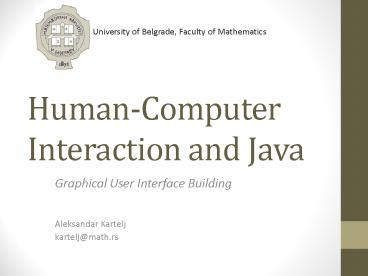Human-Computer Interaction and Java - PowerPoint PPT Presentation
Title:
Human-Computer Interaction and Java
Description:
Design perspective User-centric vs development-centric design Focusing on human ... JavaScript + AJAX + JQuery Mobile based clients J2ME MIDlets ... – PowerPoint PPT presentation
Number of Views:135
Avg rating:3.0/5.0
Title: Human-Computer Interaction and Java
1
Human-Computer Interaction and Java
University of Belgrade, Faculty of Mathematics
- Graphical User Interface Building
- Aleksandar Kartelj
- kartelj_at_math.rs
2
Outline
- Introduction
- Functional models for GUI, UML
- GUI Design (Java)
- Implementation details
- Clients and technologies
- Concluding remarks
3
Resources
- Kraemer, Elieen, A Java-based Course in
Human-Computer Interaction, PDPTA, 2000. - Lazar, Johathan, Jinjuan Heidi Feng, and Harry
Hochheiser, Research Methods in Human-Computer
Interaction, Wiley.com, 2010. - Marinilli, Mauro et al., Professional Java User
Interfaces, New York John Wiley Sons, Inc.,
2006. - Weaver, James et al., Pro JavaFX 2 A Definitive
Guide to Rich Clients with Java Technology,
Apress, 2012. - Programming Paradigms Course, Faculty of
Mathematics, University of Belgrade.
4
Introduction
- 1980s shifts in visual technology
- raster graphics,
- specialized graphic memories, processors
- I/O devices
- But, GUI design issues remained
- User happiness
- Effectiveness
- Complexity
5
Design perspective
- User-centric vs development-centric design
- Focusing on human details is critical
- Perception
- Memory
- Learning capabilities
- Central issues
- User
- Task
6
Functional models
7
Standard abstract UI model
8
Layers
9
Team
10
Early design phase
- UML use case diagrams
- Typical (happy path) scenario analysis
11
Lifecycle approaches
- Rational Unified Process (RUP)
- User experience (UX) storyboards enriching use
cases with GUI design info - Extreme programming and agile approaches
- Evolutionary prototyping
12
GRAPHICAL User interface design
13
Skipping theoretical parts
- Short term memory and cognitive modelling
- System response time and user
- Compromising between human control and automation
- Presenting the user with internal state of
application
14
User-centered design
- Single rule
- Know the user.
15
GUI example
16
Component costs
17
Design guidelines
18
Iterative development
- Prototyping
- Refactoring
- User interface testing
- Software testing
- Usability testing
- Profiling
19
Prototyping
20
Implementation details
- Design patterns inside Java GUI
21
Java GUI underlying patterns
22
Separating Presentation
- Elements that need to be separated
- Look and Feel (how the components are drawn)
- Some interaction styles (one or two clicks)
- Fonts
- Color and themes
- Provided by Swing by pluggable look and feel
- SWT and AWT enforce certain modularization
- JavaFX uses separate FXML source files
23
Data Transfer Object (Data I/O)
- Holds business data in transactions between
service providers and clients - Single method to send and receive DTO
- Decreases bandwidth
- Simplifies communication
- Usually contains only necessary information
24
Observer Pattern (Control)
- Event-based communication
- Publish and subscribe mechanism
25
CLIENTS AND Technologies
- Form-based, web-based, mobile clients
26
Form-based rich clients (1)
- Microsoft technologies (Window Forms), Flash
(Flex), Java based, - Java differences
- Full object-oriented approach
- Multi-platform execution
- Highly collaborative community
- JRE
- SWT sacrifices a part of portability for
performances
27
Form-based rich clients (2)
- Usual strategy
- Content first
- Data second (simulate moving back and forth)
- Plain Old Java Object (POJO) object
- Commands third
- AWT
- Swing
- SWT
- JavaFX
28
Web-based clients (1)
- Web environment
- Client display size, connection types, different
browsers - No state
- Cannot operate when disconnected from server
- Attention to bandwidth and interaction issues
- Web pages are defined in non-object-oriented
languages - No installation needed
29
Web-based clients (2)
- Typical business implementations
- Servlets
- JSP
- JSF (Spring, Struts,)
- Example of online game scenario
- Data Postgresql JPA (Hibernate)
- Logic Tomee Rest Services
- Presentation JavaScript AJAX JQuery
30
Mobile based clients
- J2ME MIDlets
- Limitations
- Low hardware resources
- Simplified application lifecycle
- Cost-driven design
- Other problems
31
Concluding remarks
- HCI design, implementation and evaluation of
interactive systems for humans - GUI building is its practical part design,
software architecture, code tactics - Java has good GUI related stuffs
- Widely used and well documented
- Architecture-neutral, available
- High level GUI packages
- Growing importance on the internet
32
THANK YOU FOR ATTENTION.
- kartelj_at_matf.bg.ac.rs
- aleksandar.kartelj_at_gmail.com
- www.math.rs/kartelj































